Matthew, Mark, Luke, and Tweedledum (Estero Calvo)
Part Seven of the Tale of Mollymawk's Expedition from Natales to EdenIf you take another look at that satellite image of the Peel inlet and Estero Calvo you’ll see that in the corner of this little cove which we had now entered there is a motor vessel – and to our surprise we found that it was still there, four years after the photo was taken. It’s name was Capitan Constantino. It was obviously intended to take people to look at the glaciers – it was entirely filled with ranks of seats, like a ferry – but from where would these tourists possibly come?
“They’ll have to come from a cruise ship,” said I – and I may say that the idea of a meeting a cruise ship in this most sacred venue did not appeal.
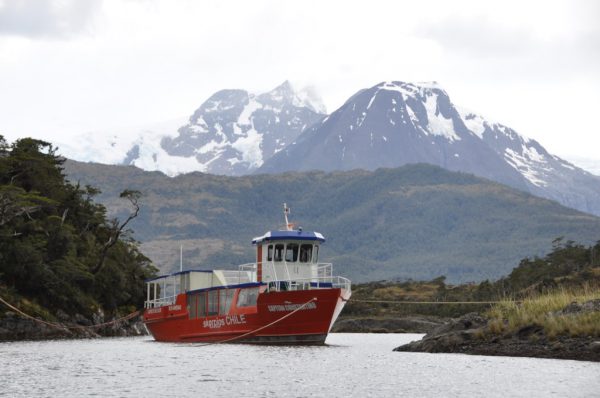
The fact that Capitan Constantino is permanently moored here probably contradicts the idea that the caleta could ever be closed by a berg – but that rock which we found in the entrance could certainly do the trick! Now that we were within I wondered if we would ever mange to find the way out again.
With the ferry occupying the nook shown in the cruising guide, we anchored on the far side of some islets and took lines ashore; and then, straight away, we hopped into the dinghy and we sounded the entrance channel again, and we drew ourselves a little plan. (There are actually two channels, but the one to westward is even worse as there’s a blinder in the middle.)
On the morrow we waited till almost high water before we brought in the mooring lines and weighed anchor, and you may be sure that we took that pass very cautiously… And we escaped.
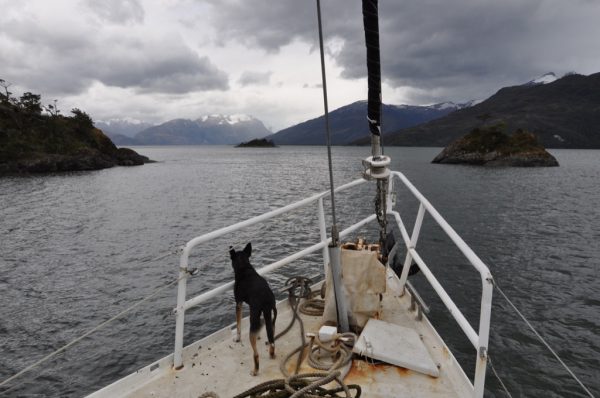
To our surprise – and to our great delight – we found that the ice which had choked the Calvo estero on the previous evening had now moved aside. It seemed to have been driven up the inlet, and since there was a fair wind we bowled along after it. A pretty sight we must have made, with our white sails out-stretched and an array of sparkling glaciers and white-capped mountains for a backdrop – but there was, of course, no one to admire us.
Even from a distance of three or four miles we had noticed that the Tilman glacier is now looking very sorry for itself. Wizened, and brown at the edges, its most prominent feature now is a large hole in the middle. As we got closer we realised that it no longer touches the sea.
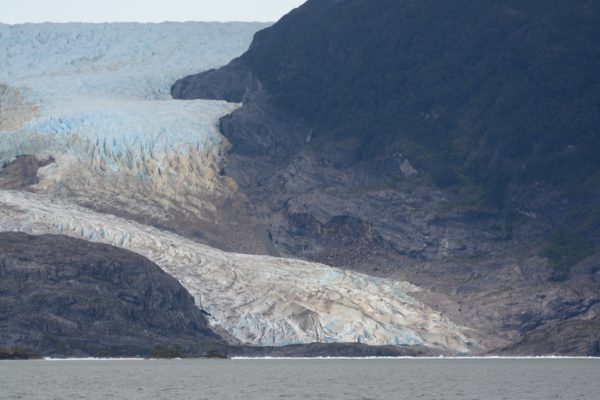
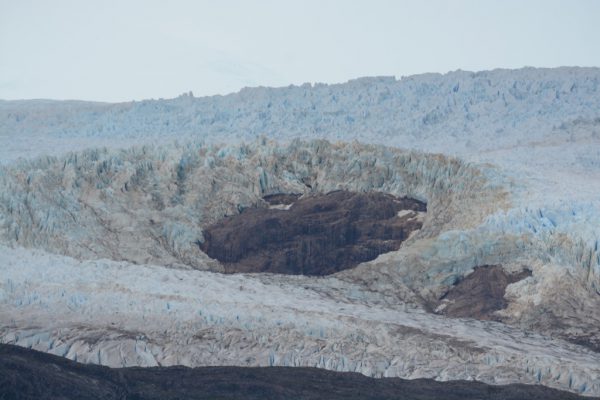
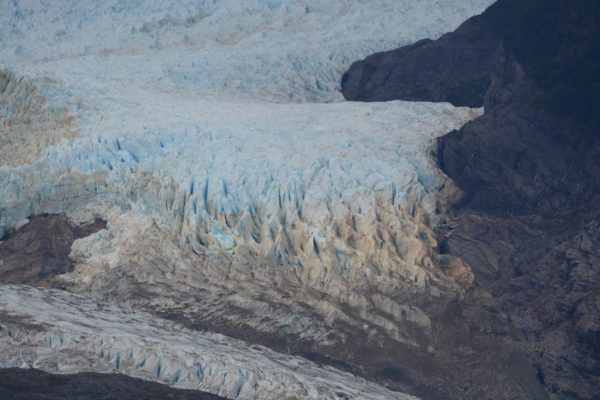
Still, there was plenty of ice in the vicinity because there is another glacier in the narrow gorge adjacent to Tilman, and this one still has a calving front. It doesn’t seem to have a name – even the Tilman glacier has, until this moment, only been known by a number! – and the glaciers in the gully on the opposite side of the fiord have also been neglected. Poor things; no wonder they’re withering away! It must be for lack of love.
So now I’ve christened them all.
If Lecky (or whoever) can get away with naming these magnificent wonders in whimsical fashion, so can I. In keeping with the pattern which he has begun, I hereby baptise the glacier next to Tilman, Glacier Mark, and the one opposite it is now called Luke. Matthew we have already met, and John is just around the corner, in a broad deep inlet extending to the south.
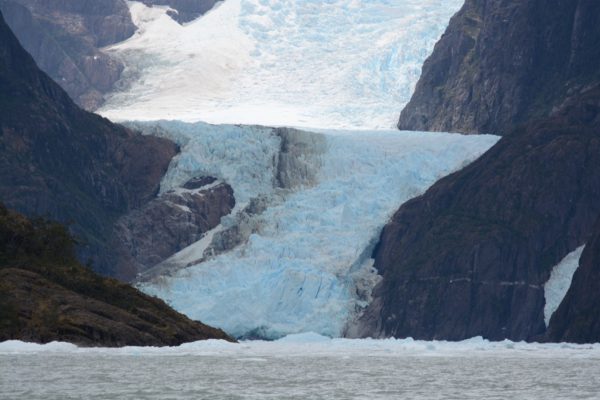
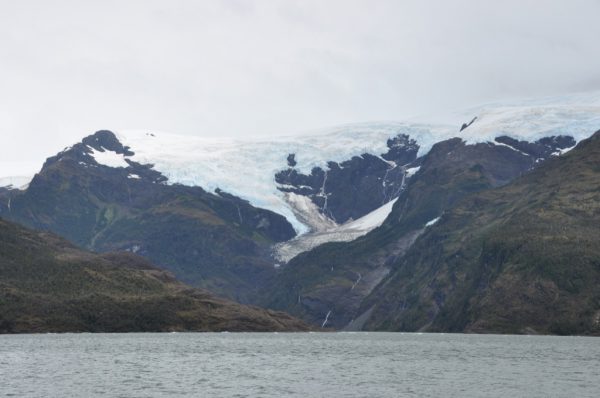
Would that I could have named them Heaton-Cooper, Constable, and Russell-Flint, after my favourite landscape painters – but then again, to name these masterpieces of Nature after mere ‘daubers’ seems almost crass; and besides, we must follow tradition and conform with the precedent already set.
Glacier John was inaccessible to us beyond a crazy-paving of ice. That was evidently where the stuff that we saw last night had all gone.
No matter.; we didn’t need to go up there. John is huge – almost as wide, at the water’s edge, as Amalia, and with a white wall astern of his snout which encompasses two valleys and the mountains above them – yet little more than a glance did I give to all this.
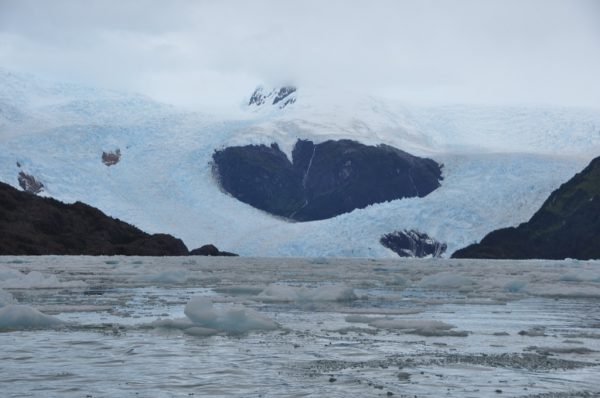
Lodged in the middle of that enormous white wall is a spectacular heart-shaped valley – a place which is surely virgin land, nestled as it is within an impenetrable forest of crevasses – yet for scarcely a minute did I peer at it through my zoom lens.
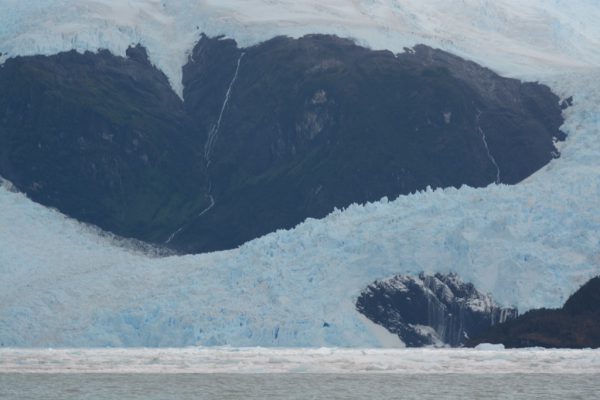
Less attention still did I give to the shower of white ice which, like a waterfall, tumbled almost constantly into one corner of the John bay.
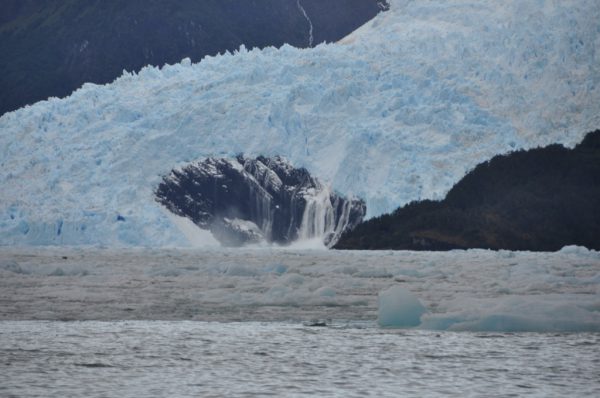
I glimpsed all of these things, but my mind was really elsewhere and my eyes too. With my whole being I was willing us up, up, up the inlet ahead of us. Right up the Calvo inlet, let us go, into that magic land which our old charts barely illustrate – it being completely unknown a that time, since it was always solid with ice – but which the satellite image reveals as a veritable glacier alley.
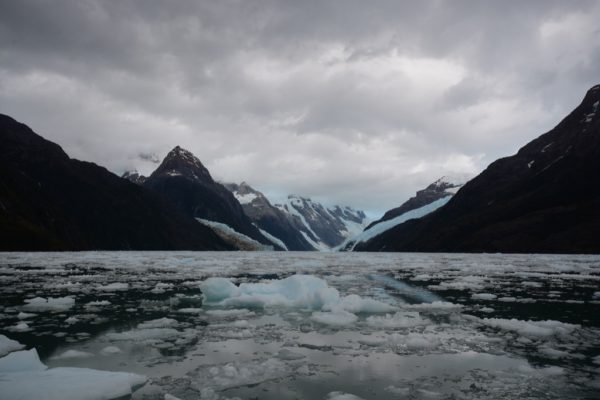
By now we sailing were amongst the floes which had been driven by the wind into this narrow valley, but there were still patches of open water; and so, having furled the genoa and started the engine, we were able to trace a careful meandering path amongst them. Ahead of us, on either side of the V, there were two or three pairs of glaciers tumbling down into the sea, and at the head of the corridor, perhaps six miles away, was a wall of ice whose blue-tinged summit merged with the clouds.
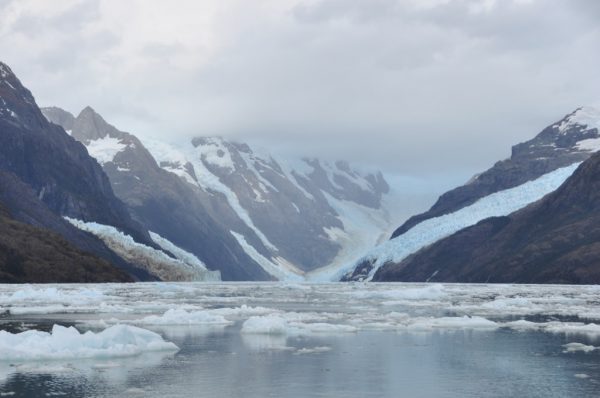
So fascinated were we by the splendour and magic of this secret world which is so inaccessible to man, that we were drawn onward into it and drawn into the ice. Eventually the skipper was having to dodge bergy-bits which, if not as large as an English cottage and its garden, were certainly as big as a Chilean fisherman’s tin house.
“Where are we actually going?” he called out to us at last. “I don’t want to spend the night anchored amongst this lot; and anyway, there’s nowhere shallow enough…”
(By now we had sailed off the edge of the chart, but the echo-sounder was steadfastly reporting ‘No Bottom’.)
I had hoped that we might wend our way to the foot of the first pair of glaciers which face each other across the icy valley. To judge from the satellite image, these twins are almost as wide as the gorge is at this point, so that it would have been a most awesome place to sit awhile. However, Tweedledee and Tweedledum, as I christened them, were still almost two miles distant; and at our present rate of progress that placed them more than two hours away.
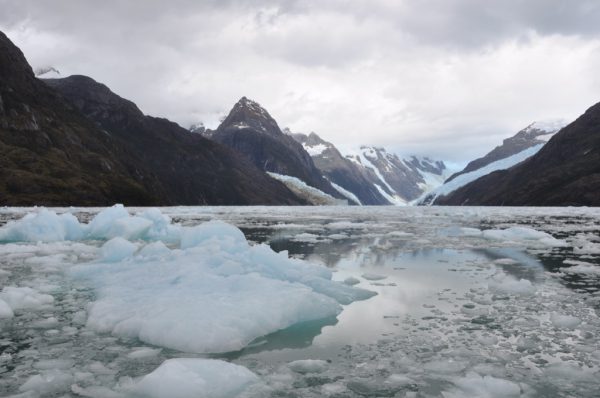
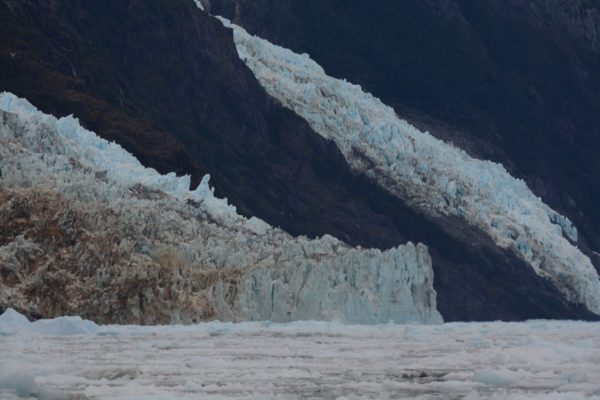
“What’s our objective here?” called the skipper – which was his way of saying, “Let’s turn back now.”
It so happened that Mollymawk was currently sitting in a relatively clear patch, and so we launched the dinghy and took some photos of her drifting there.
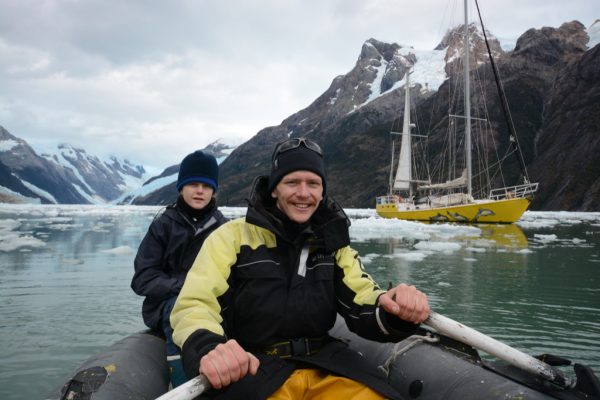
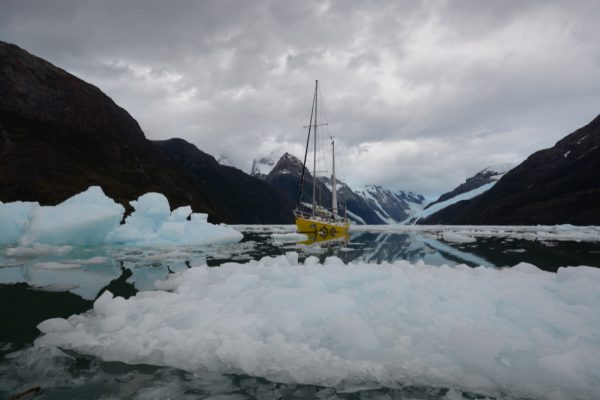
Then we got aboard and got the dinghy up again and turned about – and having finally pulled our eyes away from the view up the valley we found that the way astern was now choked with ice!
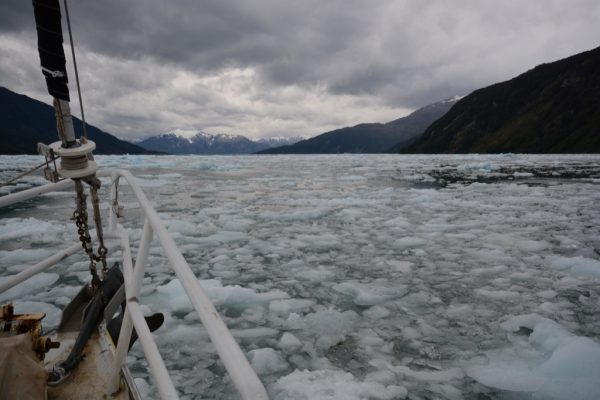
While that seductive valley of the glaciers drew us into her trap the floes had been shifting about on the tide, and a large amount of the contents of the John estero had now been sent up the main Calvo valley. Thus we now found ourselves having to do as Tilman had done, shunting our way through and around the ice.
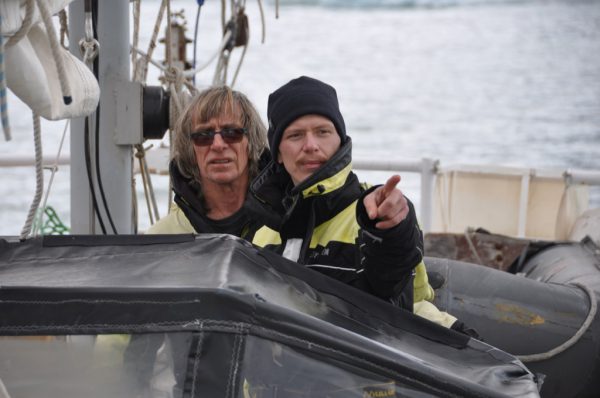
Although there were one or two massive chunks and plenty of lumps the size of a small car, most of this field of ice consisted of small pieces which had massed together to form sheets. Like enormous white lily-pads on a green pond, these conglomerations of ice were generally quite thin and we soon found that the best way to tackle all but the biggest, with a boat of Mollymawk‘s strength and weight, was by going over the top.
The bigger lily-pads were too buoyant to sink under even the weight of a 50ft steel boat – they merely resisted; and we merely had to reverse back off them again.
The chunks of ice were far more dangerous, for even when they seemed to be quite small they were very broad under the water; and these lumps are the ones which, melting faster from below than from above, spend their whole time toppling over. Even a small lump, of say a metre in width and a lot less in height, is best given a wide berth.
Caesar and I took it in tuns to stand on the bow and shout instructions to the helmsman: “Come to port! Slow down! Slower! Come to starboard!”
Thus we dodged and twisted, as if through a minefield, as we made our way back down the inlet. As Tilman says, it’s a nerve-wracking business for all the while as the boat brushes against the ice there is a crashing as of rocks against the hull and a quivering from the rig. The ice now filled the whole inlet to about the level of the Tilman glacier, and when we finally emerged Nick breathed an audible sigh of relief and said, “Let’s not do that again tomorrow, okay?”
Then he bade us hoist one of the little growlers aboard in preparation for a pisco sour.
(Pisco is the local brandy, and a pisco sour is made with pisco, lemons, and crushed ice.)
Even as we made our way back down the inlet, in the course of picking our way amongst the patchwork of floes, Caesar had suddenly spotted another boat. When you’ve grown accustomed to the idea of having the whole world to yourself such things are apt to startle if not to offend.
“What’s that doing here?”
Had the other vessel been another sailing yacht then our initial reaction might have been swiftly adjusted to one of pleasure, but it was not; it was a big red thing.
A fishing boat?
“Too big,” said Caesar, peering at the stranger through the binoculars. “I think it’s a research ship.”
“I know what it is!” said I. “It’s the cruise ship! It’s the mothership for Capitan Constantino!”
And so it proved to be, for shortly thereafter Caesar also spotted the little red ferry. It was travelling away from the ship and after crossing the inlet – and having paused for a few minutes at a place on the far side – it made its way into the John estero.
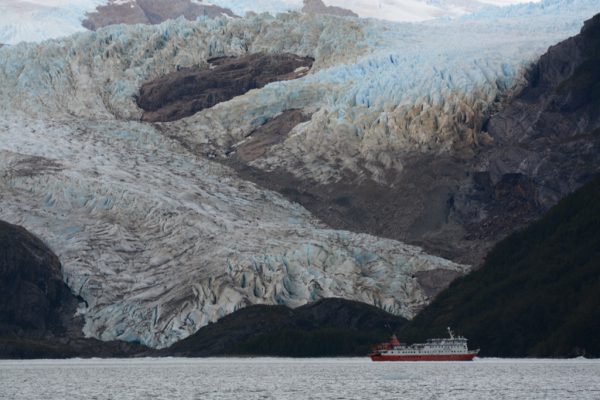
We have since done a small amount of research regarding these two vessels. They belong to a company called Skorpios, and the mothership makes regular excursions amongst the Chilean glaciers. Besides visiting the Peel inlet it also goes up Estero de las Montanas, near Puerto Natales.
Since we know nothing whatsoever about this company and have never spoken to anyone who has joined one of their expeditions we cannot actually make a recommendation, but it seems to me that for someone who yearns to see the glaciers but who does not have the time or the inclination to sail their own boat to Patagonia, this small outfit offers a very attractive alternative.
We have been told that the Peel inlet is also visited, very occasionally, by much bigger cruise ships – and this thought merely horrifies me. Besides the environmental concern (for a big ship is constantly pumping out big clouds of carbon gas), I can see no point whatsoever in viewing the glaciers from a floating city and in the company of a five hundred other people. You might just as well see the thing on your telly, for the magnificence of the glaciers and their tangible but very subtle ‘presence’ could never survive impact with mass tourism.
By now Capitan Constantino was shunting its way towards glacier John. Having broken free from our own meadow of ice we detoured to take a look at the place which he had just left. There had to be something worth seeing over there… Caesar suggested that it might be a sealion colony, and this hunch proved right. As we drew nearer to the cliffs we could hear the roaring of the bulls and the bleating of the pups.
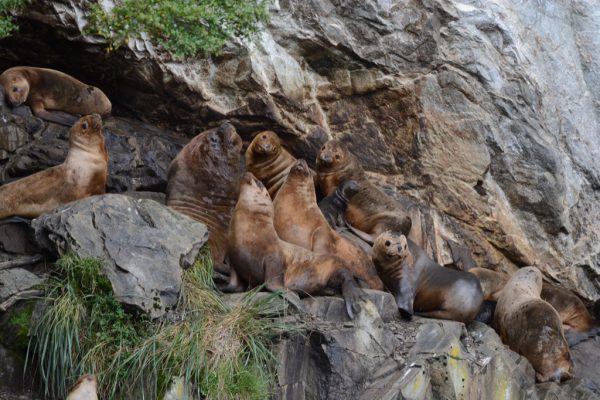
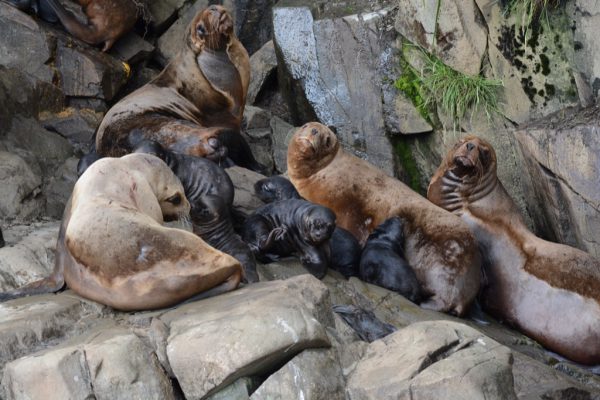
The argumentative community was perched on some sloping rocks in a narrow cleft. Above them, in the trees, a turkey vulture fluttered clumsily about. He was no doubt hoping for a meal of placenta and umbilical cord or, better yet, a still-born pup, but the only blood to be seen at the moment was on the fat faces of the biggest males. Two of them had evidently been contesting the rights to a certain female. The winner was hideously fat and horribly torn – and although he still lay at the heart of his harem he looked exhausted. Meanwhile, an equally fat but much fitter, happier bull was posing on the water’s edge and flirting with every girl who came by.
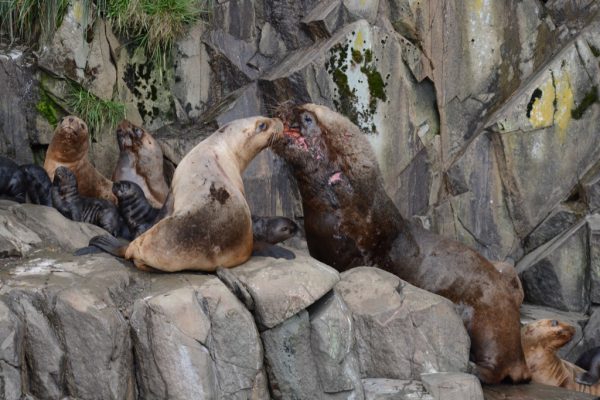
Who’d be a sealion? The blokes have such an irresistible urge to reproduce that they are driven to spend their whole lives hating all other males. And the womenfolk are so very small, by comparison, that they have little choice but do as they are bid.
“Who? Me?” said the little females nervously as the beefy young buck greeted them as they climbed out of the sea. “I’d love to, but – Oops! My hubby’s watching us! Best you be careful, darling!”
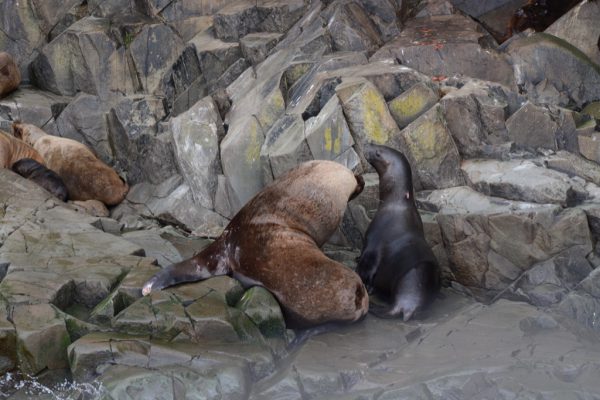
Having succumbed, the females must spend the rest of their lives raising babies. Not that there’s anything wrong with babies – in fact, I rather like them – but sealions don’t seem to particularly care for the job of mothering. More than once we saw a baby fall off the edge of the rocks as he sought to get out of the way of a ton of shuffling blubber. One which landed in the sea wailed piteously throughout the ten minutes that it spent struggling out again, and at no time did its mother so much as glance his way. When they fell and landed on the rocks we assumed that the pups must be dead, but after a short interval they would pop their heads up and begin bleating again. They are evidently well padded.
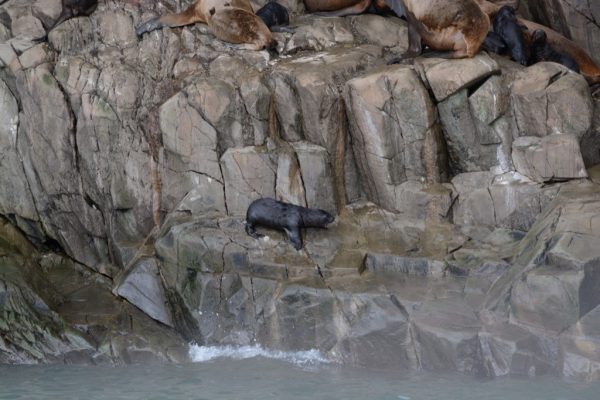
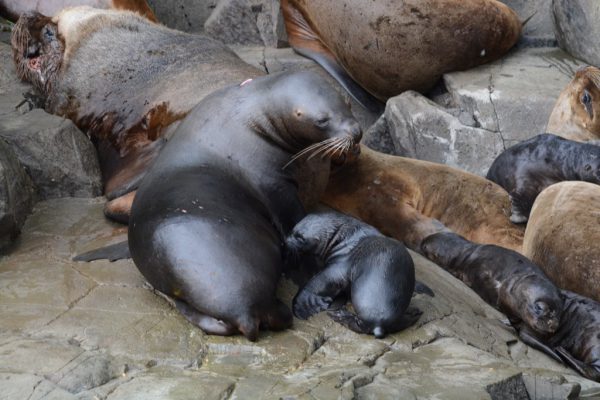
The pathetic, sheep-like bleating of the baby sealions pervaded the air, but not so much as did their stench. Even so, we would have stayed longer were it not for the fact that we had yet to find ourselves a home for the night. A return to Caleta Capitan Constantino was out of the question – we were all agreed on that point – and so we left the Calvo estuary in search of a Procter’s Bay.
